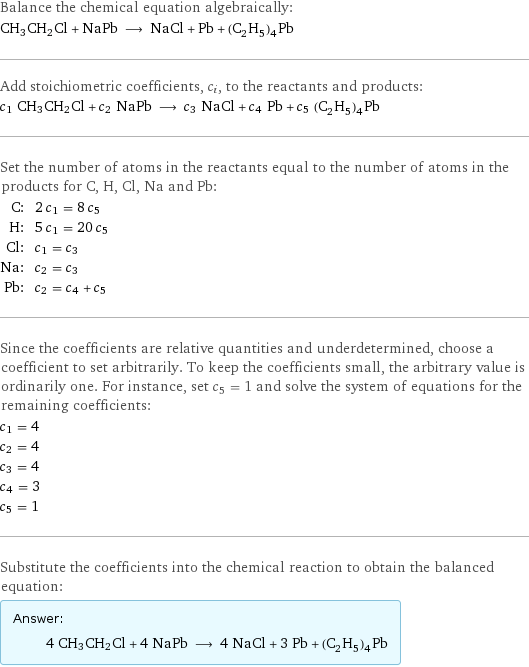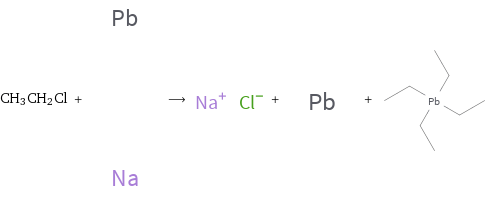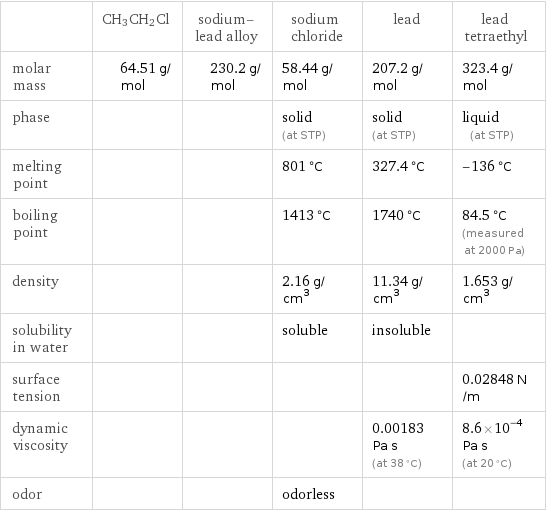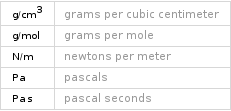Input interpretation

CH3CH2Cl + NaPb sodium-lead alloy ⟶ NaCl sodium chloride + Pb lead + (C_2H_5)_4Pb lead tetraethyl
Balanced equation

Balance the chemical equation algebraically: CH3CH2Cl + NaPb ⟶ NaCl + Pb + (C_2H_5)_4Pb Add stoichiometric coefficients, c_i, to the reactants and products: c_1 CH3CH2Cl + c_2 NaPb ⟶ c_3 NaCl + c_4 Pb + c_5 (C_2H_5)_4Pb Set the number of atoms in the reactants equal to the number of atoms in the products for C, H, Cl, Na and Pb: C: | 2 c_1 = 8 c_5 H: | 5 c_1 = 20 c_5 Cl: | c_1 = c_3 Na: | c_2 = c_3 Pb: | c_2 = c_4 + c_5 Since the coefficients are relative quantities and underdetermined, choose a coefficient to set arbitrarily. To keep the coefficients small, the arbitrary value is ordinarily one. For instance, set c_5 = 1 and solve the system of equations for the remaining coefficients: c_1 = 4 c_2 = 4 c_3 = 4 c_4 = 3 c_5 = 1 Substitute the coefficients into the chemical reaction to obtain the balanced equation: Answer: | | 4 CH3CH2Cl + 4 NaPb ⟶ 4 NaCl + 3 Pb + (C_2H_5)_4Pb
Structures

CH3CH2Cl + ⟶ + +
Names

CH3CH2Cl + sodium-lead alloy ⟶ sodium chloride + lead + lead tetraethyl
Equilibrium constant
![Construct the equilibrium constant, K, expression for: CH3CH2Cl + NaPb ⟶ NaCl + Pb + (C_2H_5)_4Pb Plan: • Balance the chemical equation. • Determine the stoichiometric numbers. • Assemble the activity expression for each chemical species. • Use the activity expressions to build the equilibrium constant expression. Write the balanced chemical equation: 4 CH3CH2Cl + 4 NaPb ⟶ 4 NaCl + 3 Pb + (C_2H_5)_4Pb Assign stoichiometric numbers, ν_i, using the stoichiometric coefficients, c_i, from the balanced chemical equation in the following manner: ν_i = -c_i for reactants and ν_i = c_i for products: chemical species | c_i | ν_i CH3CH2Cl | 4 | -4 NaPb | 4 | -4 NaCl | 4 | 4 Pb | 3 | 3 (C_2H_5)_4Pb | 1 | 1 Assemble the activity expressions accounting for the state of matter and ν_i: chemical species | c_i | ν_i | activity expression CH3CH2Cl | 4 | -4 | ([CH3CH2Cl])^(-4) NaPb | 4 | -4 | ([NaPb])^(-4) NaCl | 4 | 4 | ([NaCl])^4 Pb | 3 | 3 | ([Pb])^3 (C_2H_5)_4Pb | 1 | 1 | [(C2H5)4Pb] The equilibrium constant symbol in the concentration basis is: K_c Mulitply the activity expressions to arrive at the K_c expression: Answer: | | K_c = ([CH3CH2Cl])^(-4) ([NaPb])^(-4) ([NaCl])^4 ([Pb])^3 [(C2H5)4Pb] = (([NaCl])^4 ([Pb])^3 [(C2H5)4Pb])/(([CH3CH2Cl])^4 ([NaPb])^4)](../image_source/293a802c109c51a1aba329b8e0aaea9d.png)
Construct the equilibrium constant, K, expression for: CH3CH2Cl + NaPb ⟶ NaCl + Pb + (C_2H_5)_4Pb Plan: • Balance the chemical equation. • Determine the stoichiometric numbers. • Assemble the activity expression for each chemical species. • Use the activity expressions to build the equilibrium constant expression. Write the balanced chemical equation: 4 CH3CH2Cl + 4 NaPb ⟶ 4 NaCl + 3 Pb + (C_2H_5)_4Pb Assign stoichiometric numbers, ν_i, using the stoichiometric coefficients, c_i, from the balanced chemical equation in the following manner: ν_i = -c_i for reactants and ν_i = c_i for products: chemical species | c_i | ν_i CH3CH2Cl | 4 | -4 NaPb | 4 | -4 NaCl | 4 | 4 Pb | 3 | 3 (C_2H_5)_4Pb | 1 | 1 Assemble the activity expressions accounting for the state of matter and ν_i: chemical species | c_i | ν_i | activity expression CH3CH2Cl | 4 | -4 | ([CH3CH2Cl])^(-4) NaPb | 4 | -4 | ([NaPb])^(-4) NaCl | 4 | 4 | ([NaCl])^4 Pb | 3 | 3 | ([Pb])^3 (C_2H_5)_4Pb | 1 | 1 | [(C2H5)4Pb] The equilibrium constant symbol in the concentration basis is: K_c Mulitply the activity expressions to arrive at the K_c expression: Answer: | | K_c = ([CH3CH2Cl])^(-4) ([NaPb])^(-4) ([NaCl])^4 ([Pb])^3 [(C2H5)4Pb] = (([NaCl])^4 ([Pb])^3 [(C2H5)4Pb])/(([CH3CH2Cl])^4 ([NaPb])^4)
Rate of reaction
![Construct the rate of reaction expression for: CH3CH2Cl + NaPb ⟶ NaCl + Pb + (C_2H_5)_4Pb Plan: • Balance the chemical equation. • Determine the stoichiometric numbers. • Assemble the rate term for each chemical species. • Write the rate of reaction expression. Write the balanced chemical equation: 4 CH3CH2Cl + 4 NaPb ⟶ 4 NaCl + 3 Pb + (C_2H_5)_4Pb Assign stoichiometric numbers, ν_i, using the stoichiometric coefficients, c_i, from the balanced chemical equation in the following manner: ν_i = -c_i for reactants and ν_i = c_i for products: chemical species | c_i | ν_i CH3CH2Cl | 4 | -4 NaPb | 4 | -4 NaCl | 4 | 4 Pb | 3 | 3 (C_2H_5)_4Pb | 1 | 1 The rate term for each chemical species, B_i, is 1/ν_i(Δ[B_i])/(Δt) where [B_i] is the amount concentration and t is time: chemical species | c_i | ν_i | rate term CH3CH2Cl | 4 | -4 | -1/4 (Δ[CH3CH2Cl])/(Δt) NaPb | 4 | -4 | -1/4 (Δ[NaPb])/(Δt) NaCl | 4 | 4 | 1/4 (Δ[NaCl])/(Δt) Pb | 3 | 3 | 1/3 (Δ[Pb])/(Δt) (C_2H_5)_4Pb | 1 | 1 | (Δ[(C2H5)4Pb])/(Δt) (for infinitesimal rate of change, replace Δ with d) Set the rate terms equal to each other to arrive at the rate expression: Answer: | | rate = -1/4 (Δ[CH3CH2Cl])/(Δt) = -1/4 (Δ[NaPb])/(Δt) = 1/4 (Δ[NaCl])/(Δt) = 1/3 (Δ[Pb])/(Δt) = (Δ[(C2H5)4Pb])/(Δt) (assuming constant volume and no accumulation of intermediates or side products)](../image_source/34d11b70e74eb56475c15da5af5bea29.png)
Construct the rate of reaction expression for: CH3CH2Cl + NaPb ⟶ NaCl + Pb + (C_2H_5)_4Pb Plan: • Balance the chemical equation. • Determine the stoichiometric numbers. • Assemble the rate term for each chemical species. • Write the rate of reaction expression. Write the balanced chemical equation: 4 CH3CH2Cl + 4 NaPb ⟶ 4 NaCl + 3 Pb + (C_2H_5)_4Pb Assign stoichiometric numbers, ν_i, using the stoichiometric coefficients, c_i, from the balanced chemical equation in the following manner: ν_i = -c_i for reactants and ν_i = c_i for products: chemical species | c_i | ν_i CH3CH2Cl | 4 | -4 NaPb | 4 | -4 NaCl | 4 | 4 Pb | 3 | 3 (C_2H_5)_4Pb | 1 | 1 The rate term for each chemical species, B_i, is 1/ν_i(Δ[B_i])/(Δt) where [B_i] is the amount concentration and t is time: chemical species | c_i | ν_i | rate term CH3CH2Cl | 4 | -4 | -1/4 (Δ[CH3CH2Cl])/(Δt) NaPb | 4 | -4 | -1/4 (Δ[NaPb])/(Δt) NaCl | 4 | 4 | 1/4 (Δ[NaCl])/(Δt) Pb | 3 | 3 | 1/3 (Δ[Pb])/(Δt) (C_2H_5)_4Pb | 1 | 1 | (Δ[(C2H5)4Pb])/(Δt) (for infinitesimal rate of change, replace Δ with d) Set the rate terms equal to each other to arrive at the rate expression: Answer: | | rate = -1/4 (Δ[CH3CH2Cl])/(Δt) = -1/4 (Δ[NaPb])/(Δt) = 1/4 (Δ[NaCl])/(Δt) = 1/3 (Δ[Pb])/(Δt) = (Δ[(C2H5)4Pb])/(Δt) (assuming constant volume and no accumulation of intermediates or side products)
Chemical names and formulas

| CH3CH2Cl | sodium-lead alloy | sodium chloride | lead | lead tetraethyl formula | CH3CH2Cl | NaPb | NaCl | Pb | (C_2H_5)_4Pb Hill formula | C2H5Cl | NaPb | ClNa | Pb | C_8H_20Pb name | | sodium-lead alloy | sodium chloride | lead | lead tetraethyl IUPAC name | | lead; sodium | sodium chloride | lead | tetraethylplumbane
Substance properties

| CH3CH2Cl | sodium-lead alloy | sodium chloride | lead | lead tetraethyl molar mass | 64.51 g/mol | 230.2 g/mol | 58.44 g/mol | 207.2 g/mol | 323.4 g/mol phase | | | solid (at STP) | solid (at STP) | liquid (at STP) melting point | | | 801 °C | 327.4 °C | -136 °C boiling point | | | 1413 °C | 1740 °C | 84.5 °C (measured at 2000 Pa) density | | | 2.16 g/cm^3 | 11.34 g/cm^3 | 1.653 g/cm^3 solubility in water | | | soluble | insoluble | surface tension | | | | | 0.02848 N/m dynamic viscosity | | | | 0.00183 Pa s (at 38 °C) | 8.6×10^-4 Pa s (at 20 °C) odor | | | odorless | |
Units
